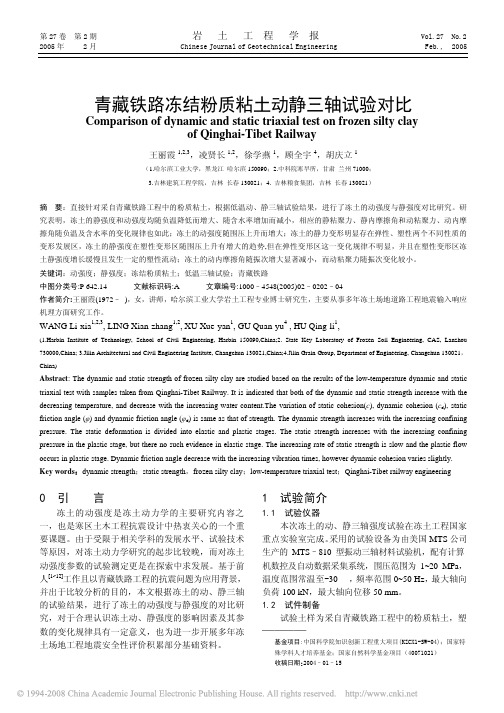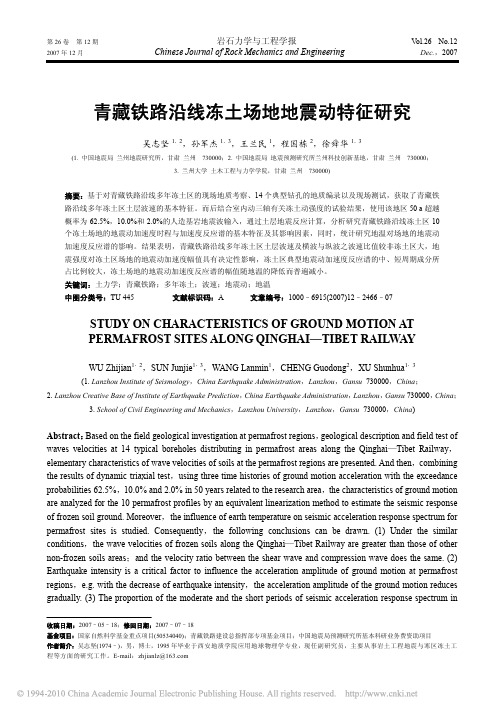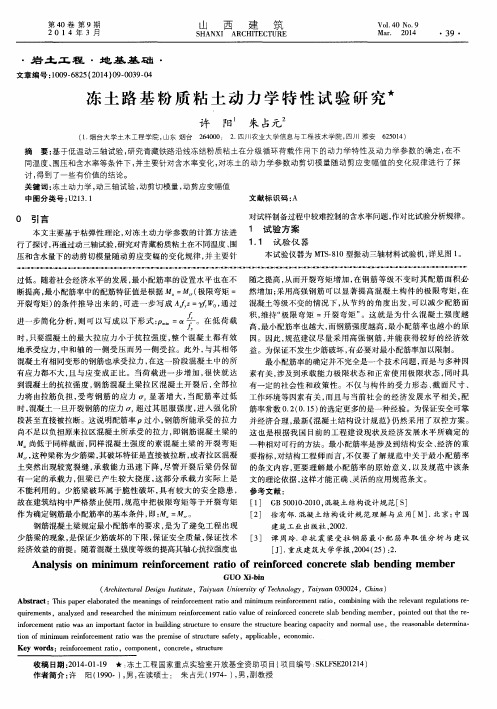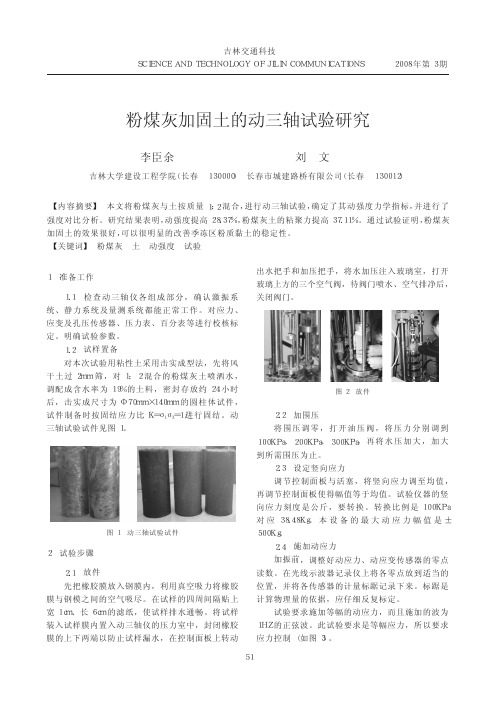青藏铁路冻结粉质粘土动静三轴试验对比
- 格式:pdf
- 大小:427.75 KB
- 文档页数:4

多年冻土块石路基蠕变变形研究张存根【摘要】由于全球气候变化,以及大规模的寒区工程建设,打破了多年冻土地区原有的地表能量平衡,导致地温升高,冻土上限逐年下降,高温冻土层厚度不断扩大,冻土蠕变变形愈加剧烈.本文通过结合青藏铁路典型多年冻土块石路基路段特征,采用变换等效导热系数法来综合考虑块石通风区的换热性质,数值模拟多年冻土路基多年蠕变变形,进行其10年、20年和30年的温度场和变形场预测,分析其蠕变情况.【期刊名称】《华北科技学院学报》【年(卷),期】2019(016)001【总页数】12页(P70-81)【关键词】冻土蠕变;块石路基;数值模拟【作者】张存根【作者单位】中交公路规划设计院有限公司,北京100088【正文语种】中文【中图分类】TU4450 引言冻土是指含冰且温度在0℃或0℃以下的各种岩石和土体,按照土处于冻结状态的持续时间可以划分为季节冻土和多年冻土[1]。
全球约有25%的陆地属于多年冻土地区,全球除澳洲外各大洲均有分布。
主要分布在纬度较高和地势较高的国家和地区,我国的多年冻土主要集中于西北和东北高海拔高纬度地区[2]。
在多年冻土地区修筑道路工程,不仅改变了路基下多年冻土的温度场,而且也改变了地基土的受力状态。
随着冻土路基温度及受力的改变,必然引起路基的力学稳定性发生变化,从而导致路基产生沉降变形。
在此情况下,在多年冻土地区,尤其在高温高含冰量地区,通常采用“主动降温”措施[3-6]的方式保证路基的热稳定性。
在青藏铁路中,块石路基是最为典型的一种冷却路基形式[7]。
喻文兵等进行了块石层降温效果的室内模拟试验,共进行6个周期的试验,每个周期8天,试验结果表明一定厚度和空隙的块石层能够有效的降低其底部的温度[8]。
张建明等模拟测试铁路碎石道渣在夏季和冬季两种情况下热传导试验,试验结果表明当碎石道渣顶部和底部温差不大时,其导热系数基本相同;温差很大时,底部导热系数明显大于顶部导热系数[9]。

第27卷 第2期 岩 土 工 程 学 报 Vol.27 No.2 2005年 2月 Chinese Journal of Geotechnical Engineering Feb., 2005 青藏铁路冻结粉质粘土动静三轴试验对比Comparison of dynamic and static triaxial test on frozen silty clayof Qinghai-Tibet Railway王丽霞1,2,3,凌贤长1,2,徐学燕1,顾全宇4,胡庆立1(1.哈尔滨工业大学,黑龙江哈尔滨150090;2.中科院寒旱所,甘肃兰州71000;3.吉林建筑工程学院,吉林长春130021;4. 吉林粮食集团,吉林长春130021)摘要:直接针对采自青藏铁路工程中的粉质粘土,根据低温动、静三轴试验结果,进行了冻土的动强度与静强度对比研究。
研究表明,冻土的静强度和动强度均随负温降低而增大、随含水率增加而减小,相应的静粘聚力、静内摩擦角和动粘聚力、动内摩擦角随负温及含水率的变化规律也如此;冻土的动强度随围压上升而增大;冻土的静力变形明显存在弹性、塑性两个不同性质的变形发展区,冻土的静强度在塑性变形区随围压上升有增大的趋势,但在弹性变形区这一变化规律不明显,并且在塑性变形区冻土静强度增长缓慢且发生一定的塑性流动;冻土的动内摩擦角随振次增大显著减小,而动粘聚力随振次变化较小。
关键词:动强度;静强度;冻结粉质粘土;低温三轴试验;青藏铁路中图分类号:P 642.14 文献标识码:A 文章编号:1000–4548(2005)02–0202–04作者简介:王丽霞(1972–),女,讲师,哈尔滨工业大学岩土工程专业博士研究生,主要从事多年冻土场地道路工程地震输入响应机理方面研究工作。
WANG Li-xia1,2,3, LING Xian-zhang1,2, XU Xue-yan1, GU Quan-yu4 , HU Qing-li1,(1.Harbin Institute of Technology, School of Civil Engineering, Harbin 150090,China;2. State Key Laboratory of Frozen Soil Engineering, CAS, Lanzhou 730000,China; 3.Jilin Architectural and Civil Engineering Institute, Changchun 130021,China;4.Jilin Grain Group, Department of Engineering, Changchun 130021,China)Abstract: The dynamic and static strength of frozen silty clay are studied based on the results of the low-temperature dynamic and static triaxial test with samples taken from Qinghai-Tibet Railway. It is indicated that both of the dynamic and static strength increase with the decreasing temperature, and decrease with the increasing water content.The variation of static cohesion(c), dynamic cohesion (c d), static friction angle (φ) and dynamic friction angle (φd) is same as that of strength. The dynamic strength increases with the increasing confining pressure. The static deformation is divided into elastic and plastic stages. The static strength increases with the increasing confining pressure in the plastic stage, but there no such evidence in elastic stage. The increasing rate of static strength is slow and the plastic flow occurs in plastic stage. Dynamic friction angle decrease with the increasing vibration times, however dynamic cohesion varies slightly. Key words:dynamic strength;static strength,frozen silty clay;low-temperature triaxial test;Qinghai-Tibet railway engineering0 引 言冻土的动强度是冻土动力学的主要研究内容之一,也是寒区土木工程抗震设计中热衷关心的一个重要课题。

第26卷第12期岩石力学与工程学报V ol.26No.12 2007年12月Chinese Journal of Rock Mechanics and Engineering Dec.,2007青藏铁路沿线冻土场地地震动特征研究吴志坚1,2,孙军杰1,3,王兰民1,程国栋2,徐舜华1,3(1. 中国地震局兰州地震研究所,甘肃兰州 730000;2. 中国地震局地震预测研究所兰州科技创新基地,甘肃兰州 730000;3. 兰州大学土木工程与力学学院,甘肃兰州 730000)摘要:基于对青藏铁路沿线多年冻土区的现场地质考察、14个典型钻孔的地质编录以及现场测试,获取了青藏铁路沿线多年冻土区土层波速的基本特征。
而后结合室内动三轴有关冻土动强度的试验结果,使用该地区50 a超越概率为62.5%,10.0%和2.0%的人造基岩地震波输入,通过土层地震反应计算,分析研究青藏铁路沿线冻土区10个冻土场地的地震动加速度时程与加速度反应谱的基本特征及其影响因素,同时,统计研究地温对场地的地震动加速度反应谱的影响。
结果表明,青藏铁路沿线多年冻土区土层波速及横波与纵波之波速比值较非冻土区大,地震强度对冻土区场地的地震动加速度幅值具有决定性影响,冻土区典型地震动加速度反应谱的中、短周期成分所占比例较大,冻土场地的地震动加速度反应谱的幅值随地温的降低而普遍减小。
关键词:土力学;青藏铁路;多年冻土;波速;地震动;地温中图分类号:TU 445 文献标识码:A 文章编号:1000–6915(2007)12–2466–07STUDY ON CHARACTERISTICS OF GROUND MOTION ATPERMAFROST SITES ALONG QINGHAI—TIBET RAILWAYWU Zhijian1,2,SUN Junjie1,3,WANG Lanmin1,CHENG Guodong2,XU Shunhua1,3(1. Lanzhou Institute of Seismology,China Earthquake Administration,Lanzhou,Gansu730000,China;2. Lanzhou Creative Base of Institute of Earthquake Prediction,China Earthquake Administration,Lanzhou,Gansu730000,China;3. School of Civil Engineering and Mechanics,Lanzhou University,Lanzhou,Gansu730000,China)Abstract:Based on the field geological investigation at permafrost regions,geological description and field test of waves velocities at 14 typical boreholes distributing in permafrost areas along the Qinghai—Tibet Railway,elementary characteristics of wave velocities of soils at the permafrost regions are presented. And then,combining the results of dynamic triaxial test,using three time histories of ground motion acceleration with the exceedance probabilities 62.5%,10.0% and 2.0% in 50 years related to the research area,the characteristics of ground motion are analyzed for the 10 permafrost profiles by an equivalent linearization method to estimate the seismic response of frozen soil ground. Moreover,the influence of earth temperature on seismic acceleration response spectrum for permafrost sites is studied. Consequently,the following conclusions can be drawn. (1) Under the similar conditions,the wave velocities of frozen soils along the Qinghai—Tibet Railway are greater than those of other non-frozen soils areas;and the velocity ratio between the shear wave and compression wave does the same. (2) Earthquake intensity is a critical factor to influence the acceleration amplitude of ground motion at permafrost regions,e.g. with the decrease of earthquake intensity,the acceleration amplitude of the ground motion reduces gradually. (3) The proportion of the moderate and the short periods of seismic acceleration response spectrum in收稿日期:2007–05–18;修回日期:2007–07–18基金项目:国家自然科学基金重点项目(50534040);青藏铁路建设总指挥部专项基金项目;中国地震局预测研究所基本科研业务费资助项目作者简介:吴志坚(1974–),男,博士,1995年毕业于西安地质学院应用地球物理学专业,现任副研究员,主要从事岩土工程地震与寒区冻土工程等方面的研究工作。


青藏铁路高温多年冻土区列车行驶路基长期永久变形数值模拟研究田立慧;凌贤长;王立娜;张锋【期刊名称】《地震工程学报》【年(卷),期】2014(000)004【摘要】With the completion of the Qinghai-Tibet Railway (QTR),several types of damage induced by traffic loads have occurred in the permafrost embankment;therefore,the safe-opera-tion demand and speed-increasing scheme of the railway will be severely affected.Permafrost is an important engineering characteristic of the QTR and is the main reason for the settlement de-formation of the embankment.The embankment deformation induced by trains includes elastic and plastic deformation.Although the residual plastic deformation will ultimately become accumu-lative permanent deformation with an increase in load number,plastic deformation might be only a small proportion of the total deformation in the embankment induced by a single train load.Une-ven deformation in an embankment is caused by excessive post-construction settling and creates a severe negative influence on the service period of a train and on the safety and comfort of its pas-sengers.Therefore,the accumulated settlement of embankment under the traffic load is an impor-tant influence factor of embankment stability.Making an accurate estimate of permanent embank-ment deformation is of great significance forguaranteeing the stability of trains and the design of railway embankments.In this study,a Duo test section is analyzed,and on the basis of dynamic tri-axial tests with samples taken from the QTR,an empirical accumulative plastic strain model is created in frozen and molten states.The CREEP subroutine is used to provide a theoretical foun-dation for calculation of permanent deformation of the QTR embankment.The results indicate that when the depth is 2.5 m or less,the accumulative permanent deformation of the embankment increases with an increase in train speed.However,when the depth is 8.2 m,the accumulative per-manent deformation decreases as the train speed increases.The cumulative plastic strain increases gradually and maintains a constant level with an increase in depth to the top of the embankment under traffic loading and increases to maximum at the embankment center.Moreover,permanent deformation increases with an increase in train speed.Further,the maximum deformation of the embankment increases from 8.9 mm to 47 mm when the axle load increases from 8 t to 25 t.Be-cause axle load has a significant influence on embankment deformation,controlling the axle load of a train may be effective in slowing the uneven deformation of the embankment.Permanent de-formation increases with an increase in train axle load,and the influence of the train axle load is reduced with an increase in depth.In addition,long-term settlement in the embankment center in-creases with an increase in the equivalent vibration.Permanent deformation increases from 31.8 mm to 35.8 mm,or 13%,when the equivalent vibration of the train is 50 000 times and 100 000 times.Afterthat,however,accumulative permanent deformation increased by5.9%,3.7%,and 2. 5% for each respective 50 000 times increase in vibration.The accumulation of permanent deform-ation of the embankment increases rapidly in the early train run and then gradually slows.There-fore,protection and repair of the embankment should be conducted early.Finally,the freeze-thaw condition has a significant effecton the accumulated permanent deformation of the embankment. The cumulative plastic deformation on the embankment surface decreases with an increase in fro-zen depth and increases with an increase in thawed depth.The work provides experimental data for further research on the dynamic characteristics of frozen soil.%基于动三轴试验建立的冻结、融化状态青藏铁路粉质黏土的累积塑性应变模型,考虑路基土体动应力的作用,二次开发适用于青藏铁路高温极不稳定多年冻土区路基长期永久变形的蠕变法则,并在既有的黏弹塑性本构模型将其引入,计算列车荷载作用下青藏铁路路基的永久变形。

2008年第3期1准备工作1.1检查动三轴仪各组成部分,确认激振系统、静力系统及量测系统都能正常工作。
对应力、应变及孔压传感器、压力表、百分表等进行校核标定。
明确试验参数。
1.2试样置备对本次试验用粘性土采用击实成型法,先将风干土过2mm筛,对1:2混合的粉煤灰土喷洒水,调配成含水率为19%的土料,密封存放约24小时后,击实成尺寸为Φ70mm×140mm的圆柱体试件,试件制备时按固结应力比K=σ1σ3=1/进行固结。
动三轴试验试件见图1。
2试验步骤2.1放件先把橡胶膜放入钢膜内,利用真空吸力将橡胶膜与钢模之间的空气吸尽。
在试样的四周间隔贴上宽1cm、长6cm的滤纸,使试样排水通畅。
将试样装入试样膜内置入动三轴仪的压力室中,封闭橡胶膜的上下两端以防止试样漏水,在控制面板上转动出水把手和加压把手,将水加压注入玻璃室,打开玻璃上方的三个空气阀,待阀门喷水、空气排净后,关闭阀门。
2.2加围压将围压调零,打开油压阀,将压力分别调到100KPa、200KPa、300KPa,再将水压加大,加大到所需围压为止。
2.3设定竖向应力调节控制面板与活塞,将竖向应力调至均值,再调节控制面板使得幅值等于均值。
试验仪器的竖向应力刻度是公斤,要转换。
转换比例是100KPa对应38.48Kg。
本设备的最大动应力幅值是±500Kg。
2.4施加动应力加振前,调整好动应力、动应变传感器的零点读数。
在光线示波器记录仪上将各零点放到适当的位置,并将各传感器的计量标踞记录下来。
标踞是计算物理量的依据,应仔细反复标定。
试验要求施加等幅的动应力,而且施加的波为1HZ的正弦波。
此试验要求是等幅应力,所以要求应力控制(如图3)。
粉煤灰加固土的动三轴试验研究李臣余刘文吉林大学建设工程学院(长春130000)长春市城建路桥有限公司(长春130012)【内容摘要】本文将粉煤灰与土按质量1:2混合,进行动三轴试验,确定了其动强度力学指标,并进行了强度对比分析。
青藏铁路主要冻土路基工程热稳定性及主要冻融灾害牛富俊;马巍;吴青柏【摘要】在介绍青藏高原多年冻土退化背景及其工程影响的基础上,通过主要冻土路基现场监测和沿线调查,对青藏铁路冻土路基2002年以来的地温发展过程、热学稳定性及次生冻融灾害进行了分析.结果表明:青藏铁路自2006年通车后冻土路基整体稳定,列车运行速度达100 km/h,达到设计要求,但不同结构路基的热学稳定性不同,采取“主动冷却”方法的路基稳定性显著优于传统普通填土路基.管道通风路基、遮阳棚路基及U型块石路基冷却下伏多年冻土的效果显著,块石基底路基左右侧对称性较差,而处于强烈退化冻土区和高温冻土区的普通路基热稳定性差,需结合路基所在区域局地气候因素予以调整或补强.以热融性、冻胀性及冻融性灾害为主的次生冻融灾害对路基稳定性存在潜在危害,主要表现为路基沉陷、掩埋、侧向热侵蚀等,其中目前最为严重的病害是以路桥过渡段沉降为代表的热融性灾害.%The background of permafrost degradation in the Qinghai-Tibet Plateau and its engineering impact in the region were introduced. Then based on the results of geo-hazard investigations and ground-temperature monitoring of the roadbeds along the Qinghai-Tibet Railway in the permafrost region1:, the development of ground temperature, thermal stability and secondary freezing-thawing hazards since 2002 were analyzed. The results showed that the roadbeds in the permafrost regions are stable in the whole since it was open to traffic in 2006. The train speed reaches 100 km/h, which achieves the design requirements. In-situ monitored results indicated that thermal stability of the roadbed constructed with a principle of "active cooling" method is much betterthan that of traditional roadbed. Among the cooling roadbeds, the duct-ventilated roadbed, sunshine-shield roadbed and U-type crushed-rock roadbed efficiently cooled the below permafrost. The roadbed with crushed-rock basement is unsymmetrical in thermal regime, and the thermal stability of the traditional roadbed is very weak, especially in the regions where permafrost is under intense degradation. Such sections should be reinforced considering the local climate factors. Along the railway, some main geo-hazards include thawing settlement, frost-heave and freezing-thawing induced hazards, and all of them might potentially influence the roadbed stability with settlement, burying and laterally thermal erosion. Currently the most serious one is the roadbed settlement in embankment-bridge transition section.【期刊名称】《地球科学与环境学报》【年(卷),期】2011(033)002【总页数】11页(P196-206)【关键词】青藏铁路;冻土;路基结构;主动冷却;热稳定性;冻融灾害【作者】牛富俊;马巍;吴青柏【作者单位】中国科学院寒区旱区环境与工程研究所冻土工程国家重点实验室,甘肃兰州730000;中国科学院寒区旱区环境与工程研究所冻土工程国家重点实验室,甘肃兰州730000;中国科学院寒区旱区环境与工程研究所冻土工程国家重点实验室,甘肃兰州730000【正文语种】中文【中图分类】P642.140 引言青藏铁路自2001年开工建设至今已10年,自2006年通车至今也已5年。
冻融作用下地铁隧道周围水泥改良黏土的静动力特性研究在极其复杂的工程地质及水文地质条件下,水泥土加固与人工冻结联合工法越来越广泛应用于隧道盾构始发、接受端头施工和已运营地铁隧道的抢险等,冻融作用下地铁隧道周围水泥改良前后黏土的静动力特性鲜有对比研究。
因此,本文通过室内静三轴试验、动三轴试验、SEM试验以及MIP试验,对比研究冻融作用下地铁隧道周围水泥改良前后黏土的静动力特性以及微观孔隙结构特征参数的变化规律,本文的主要研究成果如下:(1)静三轴试验重点考虑了掺入比、围压、冻结温度因素,对比研究冻融作用下地铁隧道周围水泥改良前后黏土的静力特性。
试验结果表明:掺入比是决定土体破坏类型、强度和刚度特性的主要因素,在围压为170 k Pa和冻结温度为-30℃时,素土和低掺量的水泥土(M<sub>br</sub>≤5%)的应力-应变曲线呈现明显的应变硬化型,表现为塑形破坏;而掺入比为10%和15%水泥土试样的应力-应变曲线随着轴向应变增大出现明显的峰值,峰值后强度明显降低,呈应变软化型,表现为脆性破坏;掺入比为7%试样的破坏类型介于脆性破坏和塑形破坏之间。
土体的静强度随着掺入比、围压的增加和冻融作用下冻结温度的降低而增大。
在冻融作用下,对于围压分别为170k Pa的试样,3%、5%、7%和10%水泥土试样最终破坏强度值比素土分别增大了0.41倍、1.05倍、2.03倍和2.26倍。
静三轴试验还得到了素土和不同掺入比下水泥土的抗剪强度指标。
素土和低掺量的水泥土(M<sub>br</sub>≤5%)在加载的初始阶段,随着轴向应变的增加,试样发生塑性应变,割线模量逐渐下降,即呈现刚度软化现象。
但随着轴向应变的继续增加,曲线渐逐平缓,衰减现象不太明显。
对于掺入量为7%和10%的水泥土在加载初期,割线模量随着轴向应变增加而增大,呈现刚度硬化现象,但当应变达到一定值后,割线模量随着轴向应变的增加而下降。
第24卷 第6期岩石力学与工程学报 Vol.24 No.62005年3月 Chinese Journal of Rock Mechanics and Engineering March ,2005收稿日期:2004–03–30;修回日期:2004–05–20作者简介:余绍水(1969–),男,现为博士研究生,主要从事工程管理、冻土工程和土木工程方面的研究工作。
E-mail :wdpan@ 。
青藏铁路沿线主要次生不良冻土现象的调查和机理分析余绍水1,3,潘卫东2,史聪慧1,3,王小军4,梁 波5(1. 中国科学院 寒区旱区环境与工程研究所冻土工程国家重点实验室,甘肃 兰州 730000; 2. 东南大学 土木工程学院,江苏 南京 210096;3. 中铁12局集团有限公司,山西 太原 030024; 4. 中铁西北科学研究院,甘肃 兰州 730000;5. 兰州交通大学 土木工程学院,甘肃 兰州 730300)摘要:经过野外调查发现,完成施工但尚未投入运营的青藏铁路沿线出现了一些次生不良冻土现象。
通过讨论这些次生不良冻土现象的分布规律和危害,认为铁路路基对地下水条件和冻土热稳定性的破坏是导致产生次生不良冻土现象的根本原因,并初步探讨了针对这些现象的工程防治措施。
关键词:土力学;青藏铁路;次生不良冻土现象;机理;调查中图分类号:P 642 文献标识码:A 文章编号:1000–6915(2005)06–1082–04INVESTIGATION AND MECHANISM ANALYSIS OF THE MAJOR SECONDARY HARMFUL FROZEN-SOIL PHENOMENA ALONGQINGHAI —TIBET RAILWAYYU Shao-shui1,3,PAN Wei-dong 2,SHI Cong-hui 1,3,WANG Xiao-jun 4,LIANG Bo 5(1. State Key Laboratory of Frozen Soil Engineering ,Cold and Arid Regions Environmental and Engineering Research Institute ,The Chinese Academy of Sciences ,Lanzhou 730000,China ;2. School of Civil Engineering ,Southeast University ,Nanjing 210096,China ;3. Twelve Bureau Group Ltd. Co.,China Railway Engineering Corporation ,Taiyuan 030024,China ;4. Northwest Research Institute of China Railway Engineering Corporation ,Lanzhou 730000,China ;5. School of Civil Engineering ,Lanzhou JiaotongUniversity ,Lanzhou 730300,China )Abstract :A number of secondary harmful frozen soil phenomena were found along Qinghai —Tibet railway which are being developed since the completion of construction of the railway. The distribution laws and danger of these phenomena are discussed. These are mainly caused by disturbance of ground water condition and thermal stability. Some key principles to control these disasters are also discussed.Key words :soil mechanics ;Qinghai —Tibet railway ;secondary harmful frozen-soil phenomena ;mechanism ;investigation1 引 言不良冻土现象,是指土体在冻结和融化作用下产生的物理地质现象。